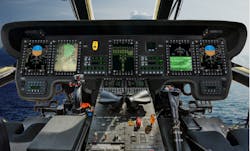Sikorsky to redesign flight-control computer avionics on CH-53K helicopters to stave-off parts obsolescence
PATUXENT RIVER NAS, Md. – Military avionics designers at Sikorsky Aircraft in Stratford, Conn., will redesign the flight-control computer aboard the U.S. Marine Corps. CH-53K King Stallion heavy-lift helicopter under terms of a $36 million three-year order.
Officials of the U.S. Naval Air Systems Command at Patuxent River Naval Air Station, Md., are asking Sikorsky, a Lockheed Martin company, to provide a CH-53K flight-control computer redesign due to obsolescence.
The order includes non-recurring engineering efforts to integrate, test, and qualify an updated flight-control computer for the CH-53K. The redesigned flight-control computer will undergo qualification testing to ensure all changes meet CH-53K performance specifications, and are backward compatible with all CH-53K flight control system hardware and software interfaces.
The flight-control computer takes inputs from the CH-53K helicopter's flight control surfaces and engine controls, and outputs to the engine-indicating-and-crew-alerting system (EICAS) and the flight management computer (FMC). The flight-control computer plays a vital role in safe flight.
Over time, some of the electronic components inside a flight-control computer can become obsolete and no longer have support from their manufacturers, which can make maintaining and upgrading these computers difficult, if not impossible.
Officials of the Navy PMA-261 CH-53 Heavy Lift Helicopters Program Office is awarding the contract to Sikorsky sole-source. Sikorsky is the designer, developer, and sole producer of the CH-53K helicopter, and the only responsible source for the flight-control computer redesign, officials say.
Sikorsky is the only known company with the data, technical skills, and requisite knowledge of the design, fabrication, performance, operation, maintenance, and support characteristics of the CH-53K helicopters to fulfill this need in a reasonable amount of time, experts say.
The CH-53K King Stallion is a large cargo helicopter designed to replace the Marine Corps fleet of CH-53E heavy-lift helicopters to help move Marines and their equipment from ships offshore onto attack beaches. The CH-53K is a general redesign of the CH-53E.
The CH-53K sea-based, long range, helicopter is designed to provide three times the lift capability of its predecessor. The CH-53K will conduct expeditionary heavy-lift transport of armored vehicles, equipment, and personnel to support distributed operations deep inland from a sea-based center of operations, Sikorsky officials say. It can lift more than 18 tons.
The CH-53K will have new engines and cockpit avionics layout, and will have more than twice the lift capacity and combat radius of the CH-53E. A wider cargo hold to enable the new aircraft to carry a light combat vehicle internally, and will have new composite rotor blades. It will use the General Electric GE38-1B engine.
It can operate at high altitudes, hot temperatures, and in degraded visual conditions; sling load 36,000 pounds; can fly faster than 200 knots; can make 60-degree-angle bank turns; can climb to 18,500 feet above sea level; conduct 12-degree slope landings and takeoffs; and can auto-jettison external loads, and survive gunfire.
The CH-53K first flew in late 2015, and the helicopter was introduced to Marine Corps squadrons in 2018. The Marines plan to buy 227 CH-53K helicopters for about $23.3 billion.
The Raytheon Technologies Corp. Collins Aerospace segment in Cedar Rapids, Iowa, is providing the CH-53K's avionics management system; Sanmina-SCI Corp. in San Jose, Calif., is providing the new helicopter's intercommunications System; and Spirit AeroSystems in Wichita, Kan., is providing the CH-53 cockpit and cabin. Other major subcontractors are GKN Aerospace in Redditch, England; and Onboard Systems International in Vancouver, Wash.
Collins Aerospace is providing the company's Common Avionics Architecture System (CAAS) for the CH-53K. The CAAS integrates several communications, navigation and mission subsystems through its Flight2 system. It uses common reusable processing elements in an open-systems architecture based on commercial standards.
The Collins Aerospace CAAS avionics initially was developed for the Special Operations Forces' MH-47 and MH-60 helicopter fleets. In addition to the CH-53K, CAAS avionics also has been selected for the CH-47F, MH-60T, MH-65E, and VH-60N aircraft.
The Sanmina-SCI FireComm Intercommunications Control System for the CH-53K uses digital processing techniques and controls. Its system architecture uses the MIL-STD-1553 avionics data bus; the IEEE 1394b data bus; 10/100 Base-T Ethernet; and TIA/EIA-485 interface ports.
On this CH-53K flight-control computer redesign, Sikorsky will do the work in Stratford and Windsor Locks, Conn; Patuxent River Naval Air Station, Md.; and Fort Worth, Texas, and should be finished by September 2025.
For more information contact Sikorsky, a Lockheed Martin company, online at www.lockheedmartin.com/en-us/capabilities/sikorsky.html, or Naval Air Systems Command at www.navair.navy.mil.

John Keller | Editor-in-Chief
John Keller is the Editor-in-Chief, Military & Aerospace Electronics Magazine--provides extensive coverage and analysis of enabling electronics and optoelectronic technologies in military, space and commercial aviation applications. John has been a member of the Military & Aerospace Electronics staff since 1989 and chief editor since 1995.

